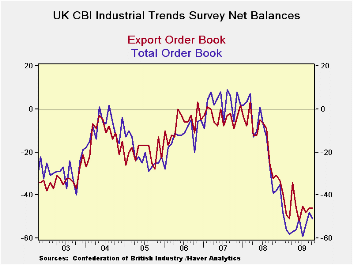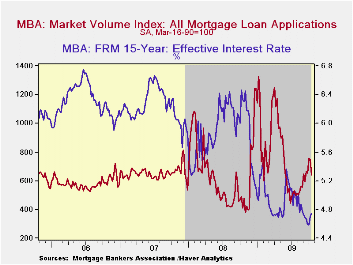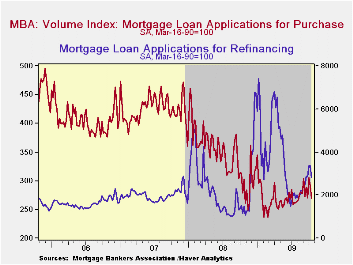 Global| Oct 21 2009
Global| Oct 21 2009UK Expected Output Turns TheCorner As Total Orders Drop
Summary
UK industrial orders according to the CBI up-minus-down net balance indicators fell in October. At a reading of -51 the orders index is above its cycle low of -59 but down from September’s -48. Export orders at a still weak -46 were [...]

UK industrial orders according to the CBI up-minus-down net
balance indicators fell in October. At a reading of -51 the orders
index is above its cycle low of -59 but down from September’s -48.
Export orders at a still weak -46 were flat at September’s level and
that strings the improvement out from the reading of -52 which was the
cycle low back in June. The volume outlook index crossed over from
negative to positive posting a +4 reading compared to the -2 it
registered in September. This switch ends a fifteen month string of
negative values for expected output.
The optimism on expected output is a good sign and one that has been long in coming. Still, the orders series remain very weak and lacks any real upward momentum. The orders series are holding their levels but these are still deeply negative readings that indicate orders are not stable but contracting. We have seen some recent readings on foreign orders elsewhere that have been spotty. In Germany, and more recently, Italy, their reports showed that ‘foreign’ orders have become irregular and progress has been set back at times. Of course, ‘foreign order’ has different meaning in different countries. While Germany rebounded from a one-month back track in its foreign orders reading, it is Italy’s newest reading that has gone negative. UK orders are weaker and its foreign orders are flat. There is more than one sign in the EU that the turn to growth may not be a smooth one. Still, UK firms are optimistic about future output trends. And that should count for something.
| UK Industrial volume data CBI Survey | ||||||||||
|---|---|---|---|---|---|---|---|---|---|---|
| Reported: | OCT-09 | SEP-09 | AUG-09 | JUL-09 | JUN-09 | 12MO Avg | Pcntle | Max | Min | Range |
| Total Orders | -51 | -48 | -54 | -59 | -51 | -50 | 12% | 9 | -59 | 68 |
| Export Orders | -46 | -46 | -48 | -45 | -52 | -42 | 11% | 3 | -52 | 55 |
| Stocks:FinGds | 10 | 13 | 13 | 20 | 22 | 24 | 36% | 31 | -2 | 33 |
| Looking ahead | ||||||||||
| Output Volume:Nxt 3M | 4 | -2 | -5 | -14 | -17 | -30 | 68% | 28 | -48 | 76 |
| Avg Prices 4Nxt 3m | -4 | -10 | -17 | -6 | -13 | -8 | 30% | 34 | -20 | 54 |
U.S. Weekly Mortgage Applications Fall As Up-Trend in Purchases Slackens
by Tom Moeller October 21, 2009

The Mortgage Bankers Association indicated that mortgage applications fell 13.7% last week. The drop left the weekly total down from the end of last month as earlier gains in applications slackened. Nevertheless, the monthly average level of applications rose 11.5% from September due to strong weekly gains during the month and a strong start to begin October.
Applications to purchase a home fell hard during the last two weeks and the declines suggest a topping of a previously firm uptrend. The latest level was roughly equal to the early-August figure. During the last ten years there has been a 51% correlation between the y/y change in purchase applications and the change in new plus existing single family home sales. The correlation has lessened recently. Applications to refinance mortgages fell hard last week but for the month so far remained up 17.5% from September and double the June low. Earlier declines in interest rates from the 2006 high had prompted refinancing at blistering 20% rate during most of 2007 and 2008.
The effective interest rate on a conventional 15-year mortgage
rose slightly last week to 4.75%. Though still down from the June
average of 5.21% and near their lowest in decades, rates have risen
slightly from the early-October low of 4.58%. For 30-year mortgages,
the rate also rose slightly last week to 5.29% after reaching a high of
5.79% in early-June. Interest rates on 15-year and 30-year mortgages
are closely correlated (>90%) with the rate on 10-year Treasury
securities. Rates on adjustable one-year mortgages rose to 6.94% last
week which was the highest level since November of last year.
During the last twelve months, the number of fixed-rate mortgage applications has risen 51.0% while the number of adjustable-rate mortgage applications has nearly tripled.
The Mortgage Bankers Association surveys between 20 to 35 of the top lenders in the U.S. housing industry to derive its refinance, purchase and market indexes. The weekly survey covers roughly 50% of all U.S. residential mortgage applications processed each week by mortgage banks, commercial banks and thrifts. Visit the Mortgage Bankers Association site here.The figures for weekly mortgage applications are available in Haver's SURVEYW database.
Gauging Aggregate Credit Market Conditions from the Federal Reserve Bank of San Francisco can be found here.
| MBA Mortgage Applications (3/16/90=100) | 10/16/09 | 10/09/09 | Y/Y | 2008 | 2007 | 2006 |
|---|---|---|---|---|---|---|
| Total Market Index | 641.0 | 742.9 | 57.1% | 642.9 | 652.6 | 584.2 |
| Purchase | 268.8 | 290.9 | -13.8 | 345.4 | 424.9 | 406.9 |
| Refinancing | 2,808.0 | 3,374.6 | 142.3 | 2,394.1 | 1,997.9 | 1,634.0 |
| 15-Year Effective Interest Rate (%) | 4.75% | 4.70% | 6.31% (10/08) | 5.9% | 6.2% | 6.3% |
Robert Brusca
AuthorMore in Author Profile »Robert A. Brusca is Chief Economist of Fact and Opinion Economics, a consulting firm he founded in Manhattan. He has been an economist on Wall Street for over 25 years. He has visited central banking and large institutional clients in over 30 countries in his career as an economist. Mr. Brusca was a Divisional Research Chief at the Federal Reserve Bank of NY (Chief of the International Financial markets Division), a Fed Watcher at Irving Trust and Chief Economist at Nikko Securities International. He is widely quoted and appears in various media. Mr. Brusca holds an MA and Ph.D. in economics from Michigan State University and a BA in Economics from the University of Michigan. His research pursues his strong interests in non aligned policy economics as well as international economics. FAO Economics’ research targets investors to assist them in making better investment decisions in stocks, bonds and in a variety of international assets. The company does not manage money and has no conflicts in giving economic advice.






